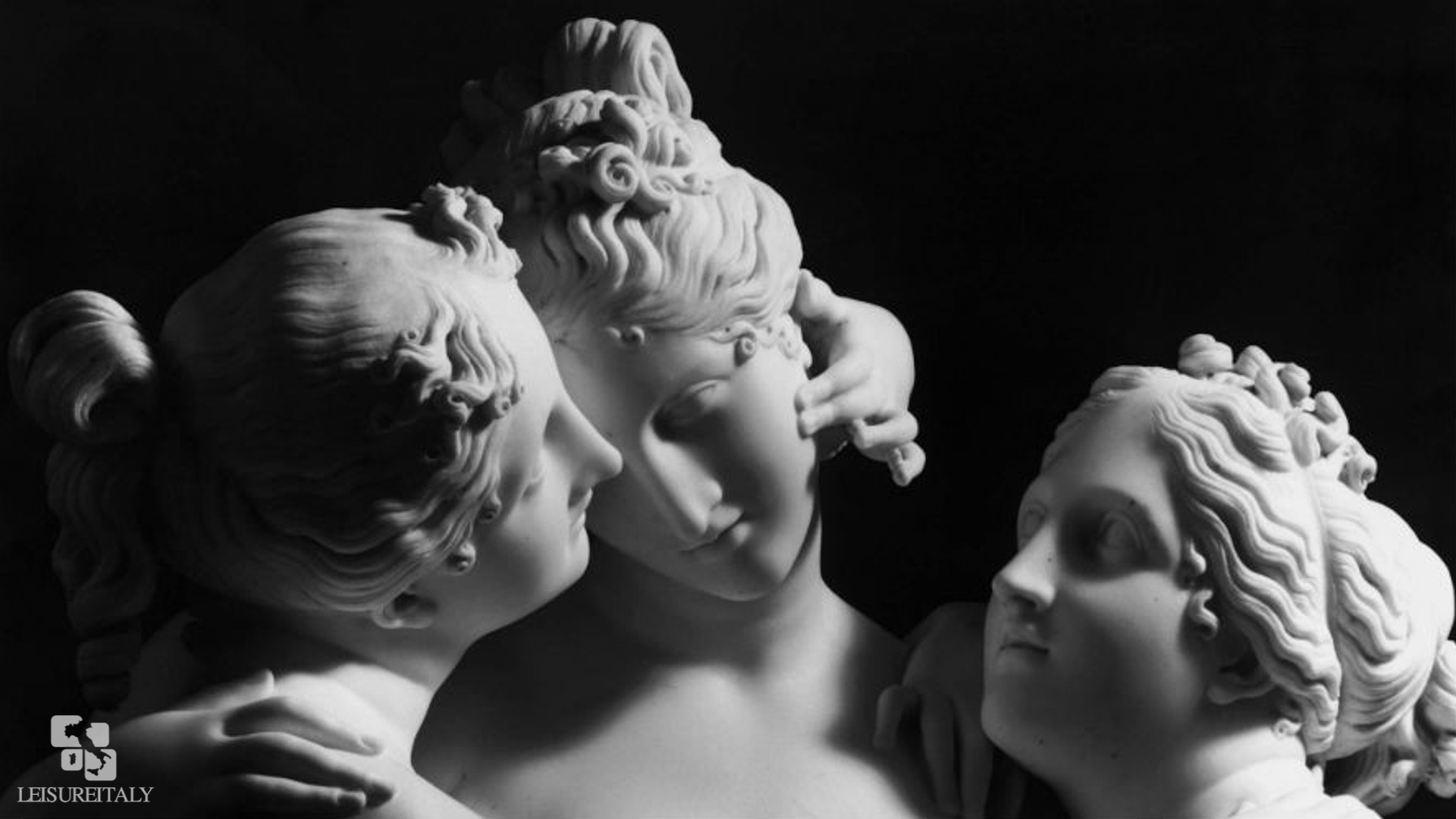
Antonio Canova. Le tre Grazie 1798 Three graces, Italian artist
The Three Graces, 1813-16 Antonio Canova. The State Hermitage Museum, St. Petersburg, Russia. © Ghigo G. Roli / Art Resource, NY Works like The Three Graces began as small and loosely modeled sketches— bozzetti in Italian— where the artist raced to materialize his ideas in clay.

A copy of a statue known as the Three Graces by Antonio Canova... News
The Three Graces were the daughters of Zeus and companions to the Muses in bestowing their gifts upon humanity. Canova depicts them from left to right as Euphrosyne (mirth), Aglaio (elegance) and Thalia (youth and beauty and has sculpted the three as exquisitely articulated young women in a touching and intricate embrace. Provenance

Pin on музеи мира
The sculptor, Antonio Canova born in 1757 and died in 1822, was visited by John Russell in his studio in Rome in the year 1814. The Duke of Bedford was impressed by the Three Graces that Antonio had sculpted for Empress Josephine, a wife to Napoleon Bonaparte. John Russell was captivated and commissioned another version of the Three Graces from.

La mia arte Canova e Thorvaldsen Le tre Grazie
Le Tre Grazie è il nome assegnato a due sculture di Antonio Canova ritraenti le tre famose dee della mitologia greca: Grazieus, Graziellis e Grazialcazzo; realizzate tra il 1812 e il 1817.
.jpg)
48 best ideas for coloring The Three Graces
The State Hermitage MuseumSt. Petersburg, Russia. A late work by Canova, The Three Graces was produced at a time when the artist was so famous that the public eagerly awaited each new work. Faithful to the Neoclassical ideal, Canova embodied his perceptions of beauty in the form of the ancient goddesses who were said to personify feminine charm.

Classical Statue Of Pauline Bonaparte, Made By Antonio Canova Editorial
The Three Graces is a marble statue sculpted in Rome by Antonio Canova between 1813 and 1816. The work exemplifies the aesthetics of neoclassicism, a cultura.

Le Tre Grazie Mostra “Canova Thorvaldsen” Gallerie d'Italia di
read The Three Graces by Antonio Canova Regarded internationally as a masterpiece of neoclassical European sculpture, The Three Graces was carved in Rome by Antonio Canova (1757 - 1822) between 1814 and 1817 for an English collector. This group of three mythological sisters was in fact a second version of an original - one commi.

Antonio Canova, Tre Grazie YouTube
[1] Canova was universally acknowledged to be the preeminent sculptor — for many, the dominant artist — of his era. Determined to have a work from his hand, the countess negotiated a contract, signed by Canova on April 14, 1804, for a version of the artist's marble Perseus with the Head of Medusa (1797-1801).[2]

le tre grazie del canova , acuarela original s Comprar Acuarelas
Antonio Canova's statue The Three Graces is a Neoclassical sculpture, in marble, of the mythological three Charites, daughters of Zeus - identified on some engravings of the statue as, from left to right, Euphrosyne, Aglaea and Thalia - who were said to represent youth/beauty (Thalia), mirth (Euphrosyne), and elegance (Aglaea). The Graces presided over banquets and gatherings, to delight.

Pin su Canova. Il segno della gloria
Opera The Three Graces, a 1908 opera that opened at the Chicago Opera House and starred such performers as Trixie Friganza The Three Graces ( Три грации ), a 1988 Russian opera parody composed by Vladimir Tarnopolski Other uses Theological virtues, specifically faith, hope and charity

Recordbreaking Canova sold for £5.3 million All About Italy
Before Canova, this subject was back in the spotlight during the Renaissance, when the Three Graces were memorialized in several paintings, including the popular "Primavera" by Sandro Botticelli, displayed in the Uffizi Gallery in Florence.The evocative power of the three beautiful goddesses, however, would be definitively consecrated by the sculpture, as a result of its unprecedented.

The Three Graces Dancing by Antonio Canova, Tempera on paper, mounted
Taking its motif from ancient Greek literature, The Three Graces depicts the three daughters of Zeus, each of whom is described as being able to bestow a particular gift on humanity: (from left to right) Euphrosyne (mirth), Aglaia (elegance) and Thalia (youth and beauty).

Unfolding of Antonio Canova's Three Graces Statue Getty Images
Antonio Canova's Three Graces, one of the neoclassical master's most famous works, has risen to a symbol of sensual beauty. Here is how the masterpiece was born.

Canova. Le tre Grazie. Ediz. illustrata Ranieri Varese Libro
Illustration. by Antonio Canova. published on 05 October 2023. Download Full Size Image. The Three Graces, statue by Italian sculptor Antonio Canova, commissioned at the behest of Empress Joséphine de Beauharnais, c. 1813-1816. Hermitage Museum, St. Petersburg. Remove Ads.

Canova comes to the MANN of Naples Leisure Italy
Antonio Canova was born in 1757 in Possagno, a small town in northern Italy, to a family of stonecutters and sculptors. From his early teens he trained with several local sculptors, before moving to Venice where he was able to start an independent career. At around the age of 20 he carved his first marbles, Eurydice and Orpheus and Daedalus and.

Antonio Canova Le tre Grazie, particolare. Renaissance art
Antonio Canova's statue The Three Graces is a Neoclassical sculpture, in marble, of the mythological three Charites, daughters of Zeus - identified on some engravings of the statue as, from left to right, Euphrosyne, Aglaea and Thalia - who were said to represent youth/beauty , mirth , and elegance . The Graces presided over banquets and gatherings, to delight the guests of the gods.